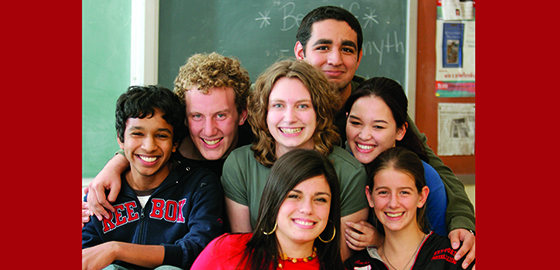The College of Education would not be able to prepare the highest quality teacher candidates without the integrated support of its Laboratory Schools made up of Metcalf School (preK through grade 8) and University High School (grades 9-12). The Laboratory Schools enroll just under 1,000 students, and classrooms serve as sites for clinical experiences that are critical to the development of teacher education students. In FY12 more than 21,000 clinical hours were clocked by Illinois State teacher education majors at Metcalf School alone.
A new way to learn
Professor Kimberly Rojas teaches an Advanced Placement (AP) Spanish course that takes advantage of a new scheduling format at University High School. At the end of every Monday’s class, her seniors bid her, “Hasta miércoles” (Until Wednesday). It may come as a surprise that Rojas does not correct them by replying, “No, hasta martes” (No, until Tuesday).
That is because Rojas has designed and implemented a hybridized course delivery format where students meet in class three days per week and work on their own each Tuesday and Thursday.
Rojas says this model allows her to focus her lessons on improving interpersonal language skills and working through difficult aspects of the language when students are in class, while giving seniors the flexibility and responsibility to develop their understanding of the language independently.
“The days we are in class we usually focus on guided practice and activities that would be difficult to do independently,” said Rojas. “This usually includes a lot of speaking.”
“On Tuesdays and Thursdays students have approximately one hour of independent work: writing and reading, grammar and vocabulary practice, and listening activities,” she said.
Rojas posts assignments using an online tool called Blackboard. She also receives homework and other assignments electronically from students using the tool. Thus, when a due date falls on one of the off days, the students have until midnight to turn it in. If a student fails to regularly turn in assignments, Rojas requires the student to come in and work with her during regular class time.
Rojas says using this mode requires her to adopt a new style of teaching.
“My whole philosophy is now much more focused on giving students time to explore the language and culture, to do extensive reading, and to develop their writing because this model has allowed them the time to do that,” she said.
As of now, Rojas still must receive Institution Research Board approval and state permission to conduct the class each year and research its effectiveness. However, student feedback and outcomes continue to be promising.
“We teach them to be responsible for their own learning and how to get back up on their feet if they fall behind. This helps to prepare them to be successful and responsible learners in college,” she said.
The course design is currently being reviewed as a pilot for the state and the hope is that one day soon it will be approved permanently.

